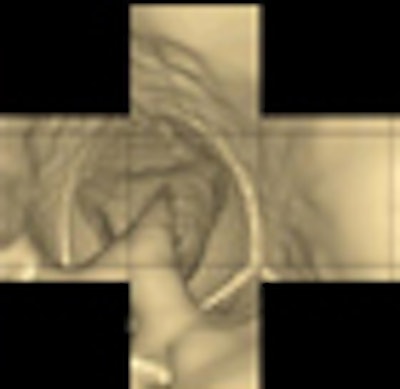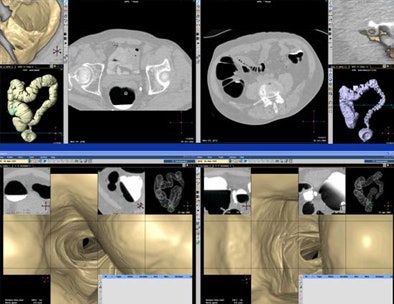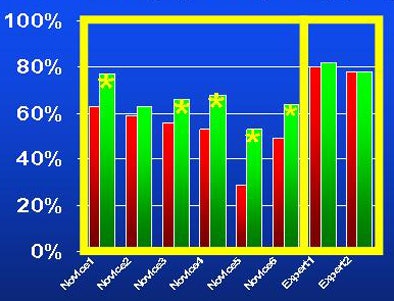
Novice virtual colonoscopy readers detect more polyps reading 3D endoluminal datasets of electronically cleansed data compared to 2D images. But experienced readers aren't daunted by either 2D datasets or fecal residues, turning in a similar performance regardless of the reading environment.
Radiologists from the Academic Medical Center, University of Amsterdam, in the Netherlands examined individuals at a somewhat elevated risk of colorectal polyps and cancer, who were recruited for virtual colonoscopy (also known as CT colonography, or CTC) screening following a positive fecal occult blood test.
Some comparison studies looking at 2D and 3D interpretation have reported high sensitivity using primary 3D for interpretation, said Dr. Ayso de Vries at the 2008 RSNA meeting in Chicago.
"This may be because the exposure time of polyps to the observers is longer using a primary 3D method, and there's a more realistic representation of reality in the 3D," de Vries said. "We hypothesize a benefit from reading primary 3D images."
 |
| Primary 3D (bottom) interpretation of CTC data may deliver greater sensitivity than primary 2D reading for trained but less experienced readers. All images courtesy of Dr. Ayso de Vries. |
But considering the widely varying results of such studies, the group wondered if there was any significant difference in accuracy between novice and experienced readers exposed to primary uncleansed 2D data versus electronically cleansed 3D images, a question their study aimed to answer.
De Vries and his colleagues, including Dr. Marjolein Leidenbaum, Roel Truyen, Dr. Shandra Bipat, and Dr. Jaap Stoker, Ph.D., examined 72 patients with a positive fecal occult blood test (FOBT) (38 women, 34 men; mean age, 59.5 ± 6.4). The cohort underwent both virtual and conventional colonoscopy after a reduced bowel preparation regimen that included a low-fiber diet for two days and the ingestion of seven 50-mL doses of oral iodinated contrast prior to CTC.
All patients were scanned using state-of-the-art techniques that included prone and supine CT data acquisition, automated CO2 insufflation, reference 40 mAs tube current modulation, thin collimation (64 x 0.625 mm), and reconstructed slice thicknesses of 0.9 mm with a tube voltage of 120 kV, de Vries said.
Electronic cleansing was performed with a new algorithm developed at Delft University of Technology.
"The algorithm shows that each voxel consists of either air, tagged material, or colonic wall material, and it calculates the percentage of each of these materials per voxel," de Vries explained. The method created a few artifacts, but generally performed well, he said.
All of the CTC data were read by six trained novice readers who had read about 50 CTC cases with feedback, and by two expert readers who had read at least 400 cases each prior to the study.
The researchers calculated the results for lesions 6 mm or larger and 10 mm or larger, and they confirmed them using segmentally unblinded optical colonoscopy for both trained novices and experts using the McNemar test. The number of false-positive findings versus colonoscopy was compared with an independent student's t-test.
"There was quite a high prevalence because all patients were FOBT-positive; 22 patients had positive results," de Vries said.
For lesions 6 mm and larger, the mean per-polyp sensitivity for novices was 49% in 2D and 63% (five of six novices, p < 0.05) in 3D, the group reported. For the experts, per-polyp sensitivity was 76% and 77%.
In false positives, the novices called a mean of 6.7 for 2D and 10.5 for 3D, compared with 10.5 and 9.5, respectively, for experts. The mean per-patient sensitivity for novices was 62% in 2D and 72% in 3D (two of six novices, p < 0.05), compared with 84% and 80% (p < 0.05), respectively, for experts.
Per-polyp sensitivity for the lesions 10 mm or larger was 69% in 2D and 78% in 3D (one of six novices, p < 0.05), compared with 91% and 87% (p < 0.05) for both experts. For the larger lesions, mean false positives were 3.2 in 2D and 3.7 in 3D for the novices, and 1.5 and 1.0, respectively, for the expert readers.
 |
| Results show sensitivity and specificity differences in primary reading of uncleansed 2D data (red) versus primary reading of cleansed 3D data (green). Top chart (above) shows per-polyp sensitivity differences in 90 lesions ≥ 6 mm; middle chart (below) shows per-polyp sensitivity in 53 lesions ≥ 10 mm; bottom chart shows specificity for novices and experts in both polyp size ranges. Novices demonstrated greater variability and lower overall performance compared to experts. |
 |
 |
"You can see there is no statistically significant difference in sensitivity between the techniques, and the [expert readers'] performance is better than novice readers," de Vries said. "For experienced readers, there is no significant difference between the two techniques."
Limitations of the study included a high prevalence of polyps, a low-dose scanning protocol, and potentially the use of iodinated contrast tagging agents, de Vries said.
"Primary-cleansed 3D results in a significantly higher sensitivity for novice readers compared to primary uncleansed 2D," de Vries concluded. "For experienced observers, who performed overall better, there was no difference between both methods."
Nevertheless, he added, the performance of observers who underwent similar training varied widely.
By Eric Barnes
AuntMinnie.com staff writer
February 5, 2009
Related Reading
Dual-energy VC makes tagged materials disappear, October 29, 2008
Wider 3D viewing angle may aid polyp detection, September 9, 2008
Thin slices more important than adequate tube current in VC CAD, June 19, 2008
Disparate VC results suggest 2D/3D debate isn't over, December 11, 2007
Debate over 2D versus 3D VC reveals subtle differences, January 21, 2005
Copyright © 2009 AuntMinnie.com

















